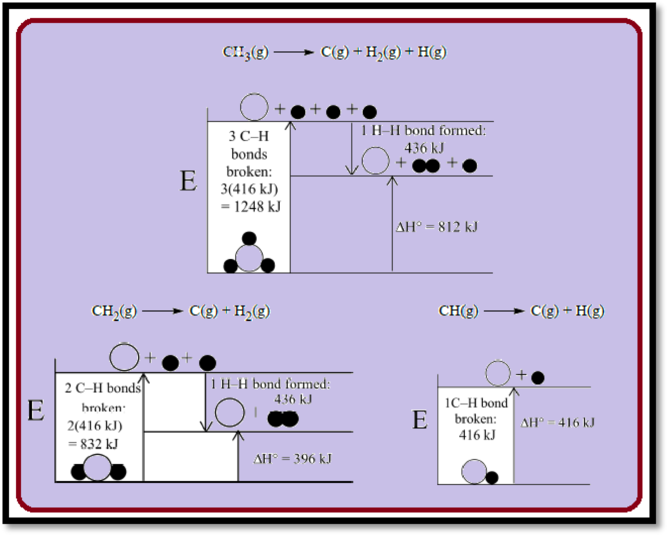
Concept explainers
(a)
Interpretation:
The average
Concept Introduction:
Bond energy means the amount of energy need to break a mole of molecules into its constituent atoms.
The expression for the enthalpy change is:
(a)
Explanation of Solution
Given,
The average
Therefore, the average bond energy is
(b)
Interpretation:
(b)
Explanation of Solution
There are four
(c)
Interpretation:
The average
(c)
Explanation of Solution
To break the

Figure 1
Average Bond Energy in gas-phase
Given,
Therefore, the average bond energy is
Average Bond Energy in gas-phase
Given,
Therefore, the average bond energy is
Average Bond Energy in gas-phase
Given,
Therefore, the average bond energy is
It is easier to break a bond in an unstable molecule than in a stable molecule.
Want to see more full solutions like this?
Chapter 6 Solutions
Chemistry: The Molecular Science
- The thermochemical equation for the burning of methane, the main component of natural gas, is CH4(g)+2O2(g)CO2(g)+2H2O(l)H=890kJ (a) Is this reaction endothermic or exothermic? (b) What quantities of reactants and products are assumed if H = 890 kJ? (c) What is the enthalpy change when 1.00 g methane burns in an excess of oxygen?arrow_forwardThe enthalpy change for the following reaction is 393.5 kJ. C(s,graphite)+O2(g)CO2(g) (a) Is energy released from or absorbed by the system in this reaction? (b) What quantities of reactants and products are assumed? (c) Predict the enthalpy change observed when 3.00 g carbon burns in an excess of oxygen.arrow_forwardThe bond energy for a CH bond is about 413 kJ/mol in CH4 but 380 kJ/mol in CHBr3. Although these values are relatively close in magnitude, they are different. Explain why they are different. Does the fact that the bond energy is lower in CHBr3, make any sense? Why?arrow_forward
- 9.41 Under what conditions does the enthalpy change equal the heat of a process?arrow_forwardThe first step in the preparation of lead from its ore (galena, PbS) consists of roasting the ore. PbS(s)+32O2(g)SO2(g)+PbO(s) Calculate the standard enthalpy change for this reaction, using enthalpies of formation (see Appendix C).arrow_forwardThe Romans used calcium oxide, CaO, to produce a strong mortar to build stone structures. Calcium oxide was mixed with water to give Ca(OH)2, which reacted slowly with CO2 in the air to give CaCO3. Ca(OH)2(s) + CO2(g) CaCO3(s) + H2O(g) (a) Calculate the standard enthalpy change for this reaction. (b) How much energy is evolved or absorbed as heat if 1.00 kg of Ca(OH)2 reacts with a stoichiometric amount of CO2?arrow_forward
 Chemistry for Engineering StudentsChemistryISBN:9781337398909Author:Lawrence S. Brown, Tom HolmePublisher:Cengage Learning
Chemistry for Engineering StudentsChemistryISBN:9781337398909Author:Lawrence S. Brown, Tom HolmePublisher:Cengage Learning Chemistry: Principles and PracticeChemistryISBN:9780534420123Author:Daniel L. Reger, Scott R. Goode, David W. Ball, Edward MercerPublisher:Cengage Learning
Chemistry: Principles and PracticeChemistryISBN:9780534420123Author:Daniel L. Reger, Scott R. Goode, David W. Ball, Edward MercerPublisher:Cengage Learning General Chemistry - Standalone book (MindTap Cour...ChemistryISBN:9781305580343Author:Steven D. Gammon, Ebbing, Darrell Ebbing, Steven D., Darrell; Gammon, Darrell Ebbing; Steven D. Gammon, Darrell D.; Gammon, Ebbing; Steven D. Gammon; DarrellPublisher:Cengage Learning
General Chemistry - Standalone book (MindTap Cour...ChemistryISBN:9781305580343Author:Steven D. Gammon, Ebbing, Darrell Ebbing, Steven D., Darrell; Gammon, Darrell Ebbing; Steven D. Gammon, Darrell D.; Gammon, Ebbing; Steven D. Gammon; DarrellPublisher:Cengage Learning Chemistry: The Molecular ScienceChemistryISBN:9781285199047Author:John W. Moore, Conrad L. StanitskiPublisher:Cengage Learning
Chemistry: The Molecular ScienceChemistryISBN:9781285199047Author:John W. Moore, Conrad L. StanitskiPublisher:Cengage Learning Chemistry & Chemical ReactivityChemistryISBN:9781337399074Author:John C. Kotz, Paul M. Treichel, John Townsend, David TreichelPublisher:Cengage Learning
Chemistry & Chemical ReactivityChemistryISBN:9781337399074Author:John C. Kotz, Paul M. Treichel, John Townsend, David TreichelPublisher:Cengage Learning Chemistry & Chemical ReactivityChemistryISBN:9781133949640Author:John C. Kotz, Paul M. Treichel, John Townsend, David TreichelPublisher:Cengage Learning
Chemistry & Chemical ReactivityChemistryISBN:9781133949640Author:John C. Kotz, Paul M. Treichel, John Townsend, David TreichelPublisher:Cengage Learning





